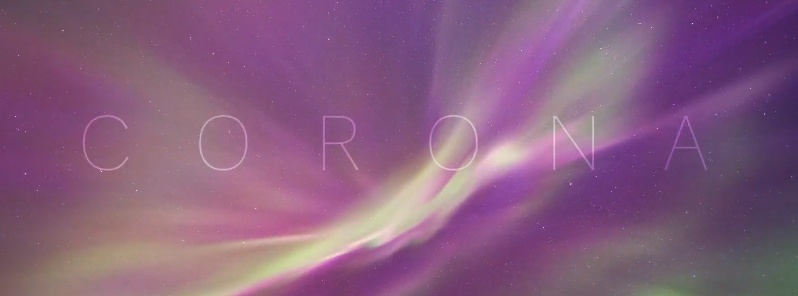‘Corona – The Zenith Aurorae’ by Adrien Mauduit

Take a break and watch this video.
'Corona – The Zenith Aurorae' by astrophotographer and nature cinematographer Adrien Mauduit
Duration: 4:43

Anyone who has ever seen a decent display of Aurora knows that it explodes to fill up the whole sky, typically during a geomagnetic storm. When that happens colorful pillars and bright bands dance and wiggle all over to the point where you don't even know where to look… unfortunately our eyes don't have a 360 view so in this particular situation the best way to avoid missing the whole picture is to lie down on the ground and just gaze up.
The most impressive aurorae of all are the one that happen just above your head. In the jargon this particular type of light is called ‘Corona’. All the pillars seem to converge into the Zenith (the point right above your head) because of the 3-D perspective created by the globe effect of the Earth. Actually it would be more correct to say that the light seams to stream outwards from a central point, much like when you are flying through a spacial vortex. Those of you who watched Star Wars or even Stargate will know what I am referring to. For this reason people that have studied or watched the aurora a few decades (even centuries) ago thought the overhead aurora described a crown (hence the name Corona).
Because of this weird perspective and the random movement of the aurora, coronas can take on a lot of different shapes and colors. Our brains are formatted to recognize patterns and a lot of people often see different shapes. Some talk about hearts or butterflies, while others see birds or dragons. That is probably why they have fed the human imagination and superstition since the dawn of time.
As my mission has always been to mix science and art, the coronas are the perfect subject to capture and have been on my film-creating list ever since I started getting interested in polar aurorae. I gathered all my best corona sequences since September 2017 and decided to compile them in a short film only dedicated to this fascinating phenomenon. In this timelapse short film I tried to showcase a lot of different types of coronas.
The first one is a unicolored blobby corona that doesn’t show more structures than a slithering green snake. It’s still extremely interesting to study the evolution of such coronas because it looks like a green liquid flowing across the sky, much like plasma (which it actually comes from). The second type of corona is probably the most visually striking because that’s when the aurora explodes into a powerful vortex of colors. The light intensity, colors structures and textures are changing so quickly that it is actually best to film them in real time rather than a timelapse. I had to shorten the shutter speed to 1 second and below to try and get the smoothest and sharpest structures, but also to avoid blowing out the highlights. Even then some parts of the aurora are overexposed and there’s just nothing you can do about it! A powerful corona can have as much light intensity as several full moons. When you’re looking at it with the naked eye, that’s when you can see colors (green, yellows, magentas…) and you can clearly see your own shadow on the ground! The last type of corona is the weak and colorful glow. They tend to happen either before a storm or right after. At high latitudes we get winter daytime aurorae (since it’s dark enough) and they tend to create extremely colorful (though faint to the naked eye) coronas (opening scene). After a type II corona, the magnetosphere usually has to ‘recover’ from such a powerful event and goes into the recovering phase where pulsating aurorae and coronas can be seen. They are fainter and flickering ones, much like in a kaleidoscope. In conclusion you are not dreaming nor are you on drugs. These coronas, though accelerated here, do happen as bright and colorful. My goal was to capture them in a very scientific and artistic way, like never before. In this purpose I used the Canon 6Da. I also used a battery of different lenses (Sigma 14mm f1.8 Art being the one I used the most). I also tried to capture deep-sky timelapse of astronomical objects in the corona like the Andromeda Galaxy, the Cygnus area, Ursa Major, or even the milky way (this will be the purpose of an entire new movie later). All post production was made in Lr with the special timelapse plus plugin, Sequence for mac, TLDF, and final production was made in FCPX. I hope you like the movie as much as I liked shooting and processing it and I thank everyone of you for your support. All content is of course copyrighted AMP&F (except sountrack licensed through The Envato Market: Curtis Schweitzer with ‘The Last Horizon’), and no footage can be used in any way without the author’s permission. Please contact me for media and purchase inquiry. Please share and comment if you liked the video and follow me for more videos like this one! More at adphotography-online.com.
Discover more of his videos on YouTube and Vimeo


Featured image credit Adrien Mauduit

Commenting rules and guidelines
We value the thoughts and opinions of our readers and welcome healthy discussions on our website. In order to maintain a respectful and positive community, we ask that all commenters follow these rules.